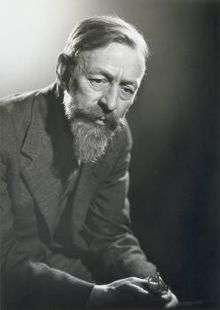Max Meldrum
Duncan Max Meldrum (3 December 1875 – 6 June 1955) was a Scottish-born Australian artist and art teacher, best known as the founder of Australian tonalism, a representational painting style that became popular in Melbourne during the interwar period. He also won fame for his portrait work, winning the prestigious Archibald Prize for portraiture in 1939 and 1940.
Duncan Max Meldrum | |
|---|---|
 Meldrum, c. 1937 | |
| Born | 3 December 1875 |
| Died | 6 June 1955 (aged 79) Melbourne, Victoria, Australia |
| Known for | Painting |
| Movement | Australian tonalism |
Early life
Meldrum was born in Edinburgh, Scotland, son of Edward David Meldrum, chemist, and his wife Christine, née Macglashan. The family emigrated to Australia in 1889. Meldrum studied at the National Gallery School in Melbourne. In 1899, he won the Victorian Travelling Scholarship, under which he chose to complete his art education in Paris.[1] Soon after, he became dissatisfied with the academic conventions of the Paris schools and left them to study on his own.[2]
He returned to Melbourne to his family in 1912, where he lived with his parents in East Melbourne, then at St Kilda. In 1915 he took a studio at 527 Collins Street, for a time sharing it with Harley Griffiths senior.
Career
He ran the Meldrum School of Painting there between 1916 and 1926. Among his students were Clarice Beckett, Colin Colahan, Auguste Cornels, Percy Leason, John Farmer, Polly Hurry, Justus Jorgensen and Arnold Shore, and had considerable influence on the work of his friend Alexander Colquhoun, whose son Archibald was also a Meldrum student at that time. In 1916-17 he was elected president of the Victorian Artists' Society, but was dropped from the position amidst controversy the following year, inspiring his students to form a breakaway group, the Twenty Melbourne Painters Society, which remains active in the Melbourne arts scene to this day. Drawing on Meldrum's principles, the group released a statement describing their central tenet:
We desire nothing but sincerity and a humble study of nature, from which alone all art, whether decorative or realistic, draws any enduring life.
Meldrum influenced the young Albert Ernest Newbury.[3]
Personal life
While living in France, he married Jeanne Eugenie Nitsch, a singer with the Opéra-Comique. Meldrum and his wife returned to Australia in 1931.
Meldrum criticized Nora Heysen's 1938 Archibald win, saying that women could not be expected to paint as well as men. The following year, he won the Archibald prize himself.
Death
Meldrum died on 6 June 1955 in Kew, Victoria, aged 79.
References
- Joyce McGrath, Bernard Smith, 'Meldrum, Duncan Max (1875 - 1955)', Australian Dictionary of Biography, Volume 10, MUP, 1986, pp 480–482. retrieved 2009-10-13
- Meldrum, Max. "The Science of Appearances", 1950.
- Colahan, Colin. "Max Meldrum:His Art and Views", 1925.
- Serle, Percival (1949). "Newbury, Albert Ernest". Dictionary of Australian Biography. Sydney: Angus and Robertson. Retrieved 13 October 2009.
| Awards | ||
|---|---|---|
| Preceded by Nora Heysen |
Archibald Prize 1939 for The Hon. G. J. Bell, Speaker, House of Representatives 1940 for Dr. J. Forbes McKenzie |
Succeeded by William Dargie |
External links
- Max Meldrum's works at the Art Gallery of New South Wales
- Max Meldrum, the Meldrumites and Montsalvat by Alex Gionfriddo
- Max Meldrum [Australian Art and Artists file] State Library Victoria